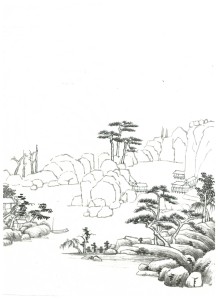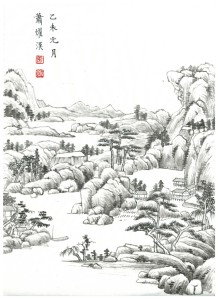This tutorial covers the following topics:
- A study of a composition by Wang Yuanqi (王原祁) (1642-1715)
- A secret to successful colouring with azuite (石青) and malachite (石綠)
- Basic knowledge of Chinese painting – Gong-bi (工筆) and Shui-mo (水墨) – also known as ‘literati’ painting
- Meaning of literati (文人)

Again we study a composition by Wang Yuanqi (王原祁) (1642-1715). There are two main reasons that we study this painting. First, the composition is very special. It looks like an aerial view of the landscape. The artist used his imagination to execute the painting as if he looked down from a high altitude. Secondly, the use of colours especially the pale green colour is very elegant. The green colour gives the impression of luxurious growth of the vegetation. The painting depicts a spring or a summer scene. More about the use of colours is discussed in the middle of this tutorial.
The background of the painting is not high mountains but a series of hills, shores and water one after another. This gives an impression a vision of depth (深遠景像).
The painting can be divided into a few parts – the near-by shore with pine trees, willow trees and trees with small foliage. Opposite to the nearby shore is a rocky shore with a boat and houses. Next to it is another shore with water rapids. The hills in the next shore are higher. The water-front houses are built on stumps. Further into the scene is another group of small hills with a plateau. Three small pine trees occupy the centre of the scene. Water separates groups of hills and shores. A few tall mountains which are vaguely visible are the farthest landform of the scene.
The painting can be copied in a few stages.
Stage 1
We start the painting by sketching the tree trunks of the foreground in pale grey ink. More branches are added using darker grey ink. Discontinued darker lines are added to the tree trunk to make the trees look sturdy and strong.
After the trees have been drawn, we can start sketching the rocks in the foreground, the near-by shore. The rocks come in different sizes, with bigger ones surrounding the smaller ones.

Stage 2
Groups of pine needles (松針) are drawn onto the branches of the pine trees. The way to drawn pine needles was introduced in Tutorial 2. The willow leaves hang vertically downward in a group of 3.
Ts’un like hemp-fibre ts’un (披麻皴) or ox-hair ts’un (牛毛皴) or a combination of the two can be added to the surface of the rocks. Use pale grey ink in the 1st layer. Let it dry a bit and add the 2nd layer. Wait until it more or less dries, add the 3rd layer and so on until the desired tone is achieved. The layers should blend well with one another.

Stage 3
Sketch the trees, hills and shores on the next layer. Ts’un (皴) is added to give the rocks more three dimensional appearance.

Stage 4
Sketch the most distant hills and shores and gently put the ts’un (皴) with a paler tone.
Stage 5
If the painting is not being coloured, a pale tone of pale ink is added to the bottoms of hills and rocks to give the structures more three dimensional appearance.
Lastly an inscription is put onto the painting.

Stage 6 colour the painting (optional)
In Tutorial 2, I introduced 4 different colours : ochre 赭石 (brown), anthocyanin 花青 (blue), cinnabar orange red 朱磦 (orange) and gamboge 藤黃 (yellow).
In this tutorial, I would like to introduce a green colour made by mixing blue and yellow together. Various shades of green can be made from the combinations of the two colours.

Two more colours: azurite (石青) and malachite (石綠) can be added to your palette. The powder pigments do not come with glue. Usually the pigments should be grounded to very fine powder with a mortar and pestle. A small amount of water is added onto the fine pigment. A very tiny amount of glue is added to the mixture so that the pigments can stick onto the paper. It is much more convenient to use those colours from tubes.

A secret to successful colouring – Both azuite (石青) and malachite (石綠) colours have to be used in conjunction with the green colour made from anthocyanin (花青) and gamboge (藤黃). They should not be directly applied to paper or silk without firstly having the paper or silk primed with green.
The few tall mountains which are vaguely visible as the farthest landform of the scene were executed with anthocyanin (花青) only without having an outline of ink. This method is called ‘mogu’ (沒骨法) painting which means ink and paint wash painting.
Please note that some malachite (石綠) was applied to the top of the plateau and the hills in the middle of the painting. The colour stands out and gives more life to the painting.

The Artist
Wang Yuanqi (王原祁) (1642-1715) was a Chinese painter of the Qing Dynasty. Wang was born in Jiangsu (江蘇) province and tutored in painting by his grandfather Wang Shimin (王時敏) (1592–1680). His style name was ‘Mao-ching’( 茂京) and his alias was ‘Lu-t’ai’ (麓台). Wang is a member of the Four Wangs (四王), four great artists of the Qing Dynasty. He followed the style of Huang Gongwang (黃公望). Wang was famous with the use of ocher pigment.
BASIC KNOWLEDGE OF CHINESE PAINTING
The two main techniques in Chinese painting are:
(1) Gong-bi (工筆), meaning ‘meticulous’, uses highly detailed brushstrokes that define details very precisely. It is often highly coloured and usually depicts figural or narrative subjects. It is mostly practised by artists working for the court or in independent workshops.

Many of this type of meticulous paintings are coloured with expensive blue and green of mineral pigments. They are known as blue-green shan shui (青綠山水). Some artists even put genuine gold lines on the outlines of hills and mountains. It is believed that this style was first formulated by Li Sixun (李思訓) (651 CE – 716 CE) a famous artist in the Tang Dynasty.
(2) Ink and wash painting, in Chinese Shui-mo (水墨) and also known as ‘literati’ painting. In theory this was an amateur art practised by learned scholars. This style is also referred to as ‘xie yi’ (寫意) or freehand style. Shan shui painting (山水畫) of hills and rivers in the native countryside was regarded as the highest form of Chinese painting.

Literati (文人), meaning scholars or scholarly civil servants of the imperial court, were all schooled in the form of Confucianism. Until the early 1900s, the term refers to the class of people who went through traditional Chinese education and strived to pass court examinations to win positions in the imperial court.
Those who did not make it to the imperial court, stayed in local villages or cities as teachers and community leaders. They devote a lot of their time in calligraphy and painting, making it very much part of daily activities among educated people.
Acknowledgements:
I would like to thank Mr Ip (葉哲豪老師), my teacher and my mentor, for giving me his great collections of fine pigments which are quite rare nowadays.
I would also like to thank Irene, my wife for proof-reading my pages, correcting my grammatical mistakes and for her unfailing support and consistent encouragement.
Further readings:
Landscapes of the WANGS: Paintings by Wang Shimin, Wang Yuanqi and Loudong School from the Palace Museum and Shanghai Museum, (2011), Macau Museum of Art
Cahill, James (1960), Chinese Painting, Skira
http://zh.wikipedia.org/wiki/%E7%8E%8B%E5%8E%9F%E7%A5%81#.E5.BC.9F.E5.AD.90
http://en.wikipedia.org/wiki/Wang_Yuanqi
http://baike.baidu.com/view/123800.htm
http://en.wikipedia.org/wiki/Blue-green_shan_shui
http://baike.baidu.com/view/756102.htm (‘mogu’ painting, 没骨法)
http://www.chinaonlinemuseum.com/painting-li-sixun.php (Li Si-xun 李思訓)
http://zh.wikipedia.org/wiki/%E6%9D%8E%E6%98%AD%E9%81%93 (Lǐ Zhāo-dào 李昭道)
https://www.google.com.au/?gws_rd=cr,ssl#q=Ni+Tsan+ (Ni Tsan)

Thank you Patrick.
I have received much enjoyment and a better understanding of the beautiful traditional art of Chinese Landscape. Congratulations on the clarity and technical skills demonstrated in your tutorials, and as always with your art, with your students and with your friends -your blog is an expression of your generosity and kindness, Patrick.
Best regards, Lucy East
LikeLiked by 1 person
Thank you for your general information about the Chinese Lunar New Year which had enriched our knowledge of the related customs and traditions.
The Landscape painting tutorials were put together clearly and systematical as a guide for beginners and it will help even more if techniques such as ‘t’sun’ and ‘dian tai’ were dealt with in more detail.
I’ve enjoyed your demonstration of using colours in the last lesson. Thank you for sharing and passing on your knowledge so generously!
LikeLiked by 1 person
I will write more about ‘dian tai’ 點苔 in my future tutorials. Thank you very much for the suggestions and your kind words.
LikeLike
It is greatly appreciated that you have showed us another tutorial of landscape paintings. The explanation of the mineral pigments/colours are very important in learning the Chinese painting, in particular, to the ‘dummy as me’. Your finished work of painting are marvellous and it is really hard to copy as yours, I may have to take ages before getting the expertise skills as yours.
LikeLiked by 1 person
Good morning Patrick
Excellent and detailed tutorial. The historical context is also very interesting.
It gives a feeling of going through the minds of the artists as they are composing their beautiful paintings.
More please
Dorothy
LikeLiked by 1 person